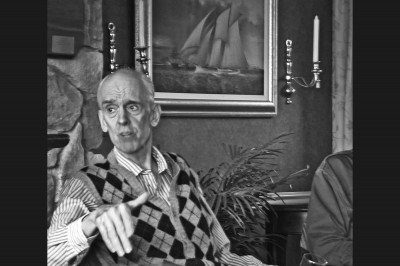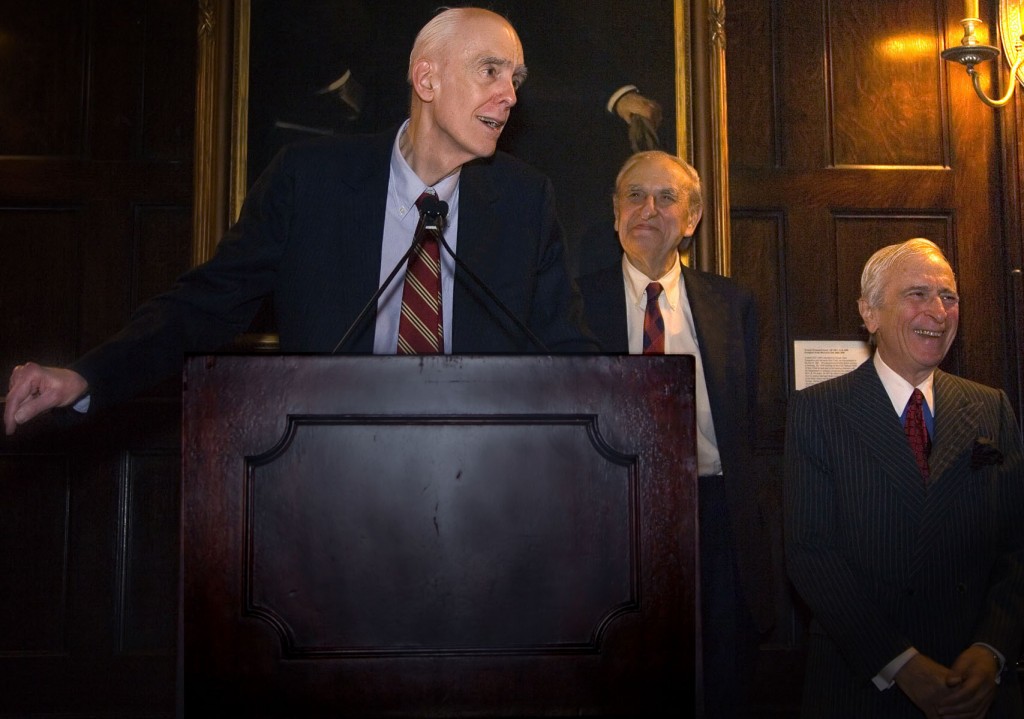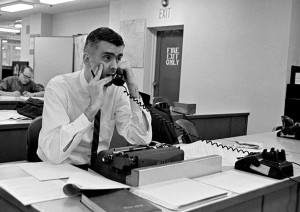
Gegrapha stalwart & renowned New York Times reporter John McCandlish Phllips passes away
from Christianity Today
John McCandlish Phillips: Bright Light for Christ in the Big Apple. The New York Times stylist mixed his love of the Lord with his love of journalism.
by Tony Carnes
John McCandlish Phillips’ eyes rolled open as I stood silently by his bedside with my wife Darilyn Saturday night. He raised his brow upward in greeting. His eyes cleared and his left hand moved up in a weak wave.
The legendary reporter for the New York Times was laid low by failing lungs, but he ministered to the very end. He encouraged, mentored, and prayed. John was a genius in giving deft encouragement to everyone who visited him with those wrinkles on his forehead rising and eyes growing large with warmth and encouragement.
A few days earlier he was still able write, though unable to speak through the breathing apparatus (he laughed with pleasure when I called it his astronaut mask). In wobbly block letters he would write bedside orders for the visitor to continue their calling in the Lord. His friends collected a whole book of these “marching orders of the Lord via John.” You always felt that it was such a privilege, such a joy, and such an encouragement.
Weaving his writing up and down the page, he wrote a large bedside order to me. “Your Story, the photographer Jacob Riis, must be fully told.” Riis was the outstanding Christian reporter in his day 100 years ago, just as Phillips was in his. In 2007, Phillips won the Jacob Riis award for lifetime achievement in journalism from the Christian journalist group Gegrapha. The group thanked Phillips for “exemplifying the values, integrity and journalistic excellence practiced by New York reporter and photojournalist Jacob Riis.”
Phillips passed away Tuesday morning, April 9, 2013 in Manhattan.
Phillips was born in Glen Cove, New York, on Long Island on December 4, 1927. He was known as Johnny, though later he warned people that he didn’t like to be called that. Directly from high school, he started work as a reporter. While in the army, he attended a church service at which he was born again.
After getting out of the Army, Phillips worked for the Times from 1952 to 1973, mostly as a reporter in the Metro section. He kept a big Bible on his desk, which he frequently consulted. He also had a way of praying stories into being.
One time Phillips was stumped on how to do a breaking news story from his desk on a train derailment in New Jersey. He didn’t have much time; I believe it was something like 40 minutes before he had to file the story. He walked to the water cooler, all the while praying. He took a drink, and walked back praying. At his desk he realized that he could try to call businesses that were situated along the area of the railway crash. He quickly found a businessman who said he saw the whole crash from his store. “God answers prayer! He sure does!” John told me. He scooped everyone with his story and its eyewitness account.
His most famous story was a front page profile in 1965 of the New York leader of the Klu Klux Klan. Headlined “State Klan Leader Hides Secret of Jewish Origins,” the story was a terrifically reported profile of Daniel Burros, a 28-year-old Queens man who was the Grand Dragon. The reporting was dangerous and the Times offered to assign bodyguards to Phillips, an offer that he waved away before the article was printed. Phillips went personally to Burros to confront him with the story and in effect to give him a chance to repent. Burros didn’t change his views but later committed suicide. After publication, the Times insisted on security for Phillips.
He also wrote the About New York column. He wrote of missionaries coming home, ne’er do wells in Times Square, and a dramatic skit about monks and their bells. Phillips described the action on stage: “The time has come to ring the bells, And, O, how those bells are pealed that morning! Around and around the monks go in widening circles, running, skipping, leaping, twining their ropes together! Into the air they go, denying their last inhibition, greeting the new, the hilarious morning!” …

Phillips receiving Gegrapha’s Jacob Riis Award. Right: Art Gelb, former managing editor of The New York Times; and Gay Talese, writer.
The rest of the story from Christianity Today:
John McCandlish Phillips: Bright Light for Christ in the Big Apple. The New York Times stylist mixed his love of the Lord with his love of journalism.
from The New York Times
McCandlish Phillips, Who Exposed a Jewish Klansman, Is Dead at 85
By Margalit Fox
McCandlish Phillips, a former reporter for The New York Times who wrote one of the most famous articles in the newspaper’s history — exposing the Orthodox Jewish background of a senior Ku Klux Klan official — before forsaking journalism to spread the Gospel, died on Tuesday in Manhattan. He was 85.
The cause was complications of pneumonia, said Jaan Vaino, a friend.
Even in a newsroom that employed Gay Talese, David Halberstam, Richard Reeves and Ada Louise Huxtable, Mr. Phillips, who was with The Times from 1952 to 1973, stood out.
He stood out as a tenacious reporter and a lyrical stylist — an all-too-rare marriage on newspapers then — and in his hands even a routine news article seldom failed to delight.
Consider Mr. Phillips’s 1961 account of New York’s St. Patrick’s Day parade, an annual millstone for the city’s general-assignment reporters:
“The sun was high to their backs and the wind was fast in their faces and 100,000 sons and daughters of Ireland, and those who would hold with them, matched strides with their shadows for 52 blocks. It seemed they marched from Midtown to exhaustion.”
In his 2003 memoir, “City Room,” Arthur Gelb, a former managing editor of The Times, called Mr. Phillips “the most original stylist I’d ever edited.”
Mr. Phillips stood out in other ways. About 6 feet 5 inches tall and not much more than 160 pounds, he was often described as a latter-day Ichabod Crane — “the man of the awkward gait and the graceful phrase,” his editors called him.
An evangelical Christian, he kept a Bible on his desk and led prayer meetings for like-minded colleagues (there were none when he joined the paper, he noted ruefully) in a conference room off the newsroom.
He refrained from smoking, drinking, cursing and gambling, each of which had been refined to a high, exuberant art in the Times newsroom — the last of these to such a degree that at midcentury the newspaper employed two bookmakers-in-residence, nominally on the payroll as news clerks.
Mr. Phillips’s most renowned article appeared on Page 1 on Sunday, Oct. 31, 1965, under the headline “State Klan Leader Hides Secret of Jewish Origin.” It was a rigorously reported profile of Daniel Burros, a 28-year-old Queens man who was the Grand Dragon of the New York State Ku Klux Klan, a chief organizer of the national Klan and a former national secretary of the American Nazi Party.
Mr. Burros, the article went on to document, was also a Jew — a former Hebrew school student who had been bar mitzvahed at 13.
The article remains a case study in a reporter’s perseverance in the face of intimidation. It is also a case study in the severe, unintended consequences that the airing of fiercely guarded truths can have for the guardian: despite threatening to kill Mr. Phillips if the article went to press, Mr. Burros, in the end, killed only himself.
John McCandlish Phillips Jr. was born in Glen Cove, N.Y., on Long Island, on Dec. 4, 1927. His father was a traveling salesman, and young Johnny, as he was known, would attend 13 grammar schools across New York, Ohio and Massachusetts.
After graduating from Brookline High School, near Boston, he forwent college for reporting and editing jobs on small New England papers. From 1950 to 1952 Mr. Phillips served with the Army at Fort Holabird, in Baltimore, and it was there, he said, that he attended the church service at which he was born again.
Mr. Phillips joined The Times as a copy boy in November 1952, later working as a clerk on the city desk and in the Washington bureau. In 1955, he was made a cub reporter and consigned to prove his mettle in the paper’s Brooklyn office, then a dank, decrepit outfit near Police Department headquarters in the borough’s nether regions.
His account of life there, written for Times Talk, the newspaper’s house organ (“It is impossible to tell a plainclothes detective from a mugger here. You just have to wait to see what they do”), so delighted the newspaper’s management that his sentence was commuted to service in the main newsroom.
In October 1965, The Times received a tip about Mr. Burros’s Jewish upbringing. Assigned to pursue it, Mr. Phillips, aided by newsroom colleagues, spent days reconstructing his life, scouring school, military, employment and police records; amassing photographs; and interviewing neighbors and associates.
The one thing they lacked was an interview with Mr. Burros: efforts to reach him had been unsuccessful. Finally, on a return visit to South Ozone Park, the Queens neighborhood in which Mr. Burros lived, Mr. Phillips glimpsed him on the street — “a round, short, sallow young man who looked a little like a small heap of misery,” he would later write in Times Talk.
He approached Mr. Burros, and they went into a luncheonette. The conversation, which ranged over Mr. Burros’s brilliant scholastic record — he had an I.Q. of 154 — and his rise to power in the Klan, was cordial.
Then, nearly 20 minutes into the interview, Mr. Phillips raised the subject of Mr. Burros’s Jewishness.
“If you publish that, I’ll come and get you and I’ll kill you,” Mr. Burros said. “I don’t care what happens to me. I’ll be ruined. This is all I’ve got to live for.”
By the time the two men parted, Mr. Phillips later wrote, Mr. Burros had threatened his life half a dozen times.
Mr. Phillips returned to the newsroom, and The Times arranged for round-the-clock bodyguards. He wrote his article, detailing Mr. Burros’s religious upbringing, his early fascination with far-right ideologies and his advocacy of genocide for Jews and blacks. On the day the article was published, Mr. Burros committed suicide.
The article cemented Mr. Phillips’s reputation as one of the city’s most esteemed reporters. He spent his remaining years at The Times primarily in the paper’s Metropolitan section, where his portfolio included the About New York column.
Mr. Phillips became known in particular for his coverage of the city’s vaunted, vanishing institutions, as in this 1969 article about the closing of the original Lindy’s delicatessen, which began:
“What kind of a day is today? It’s the kind of a day that if you wanted a slice of cheesecake at Lindy’s, you couldn’t get it.”
Near the end of the article, he wrote, with plain-spoken, impeccable logic:
“The locusts stripped the place of menus and ashtrays and other mementos. There were conflicting claimants to possession of the last bagel. As a souvenir, a bagel is not much good. It is perishable and it also lacks proof. Anyone can hold up a bagel and say, ‘This is the last bagel from Lindy’s.’ ”
Mr. Phillips resigned from The Times in late 1973 for a life in religion.
In 1962, he had helped found the New Testament Missionary Fellowship, a Pentecostal congregation in Manhattan. Its tenets, as Ken Auletta wrote in a 1997 New Yorker profile of Mr. Phillips, include the belief that “pornography, drugs, abortion and any form of fornication (including premarital sex and homosexuality) are sins.”
In the early 1970s, the New Testament Missionary Fellowship made headlines after the kidnapping or attempted kidnapping of several of its congregants by their families. The families maintained that the group had trained the congregants to repudiate them.
After leaving The Times, Mr. Phillips lived, in Mr. Auletta’s account, a contented if threadbare existence, preaching the Gospel on the Columbia University campus, near his home, and managing the fellowship’s affairs. The fellowship, which has long since ceased to incur unfavorable notice, is still extant, based in Upper Manhattan.
Mr. Phillips, who never married, is survived by a sister, Janet DeClemente.
He published several books, including “City Notebook” (1974), a collection of his articles from The Times, and “What Every Christian Should Know About the Supernatural” (1988).
Over the years, Mr. Phillips was asked whether he felt responsible for Mr. Burros’s suicide. He felt “a vague sense of sadness,” he said, but no guilt.
His stance — the view from the prospect where his faith and his journalism converged — was encapsulated in a remark he made to Mr. Gelb.
On the afternoon of Oct. 31, 1965, Mr. Gelb phoned Mr. Phillips to tell him, very gently, that Mr. Burros had shot himself.
“What I think we’ve seen here, Arthur,” Mr. Phillips replied, “is the God of Israel acting in judgment.”
Daniel E. Slotnik contributed reporting.
Click for the rest of the story from The New York Times
from reporter Evelyn Juan, Toronto, Canada
A life well-lived is a life well-shared. And John has shared his life generously so that people will not only come to know Christ, but also be grounded on what God has called them to be. That’s how he has impacted me.
I remember meeting John for the first time in 2001 at a Gegrapha event when I was a newbie in NY who was trying to break into the local scene as a reporter. He was very affirming from day 1, and reminded me that journalism is more than just a job – “You know, Evelyn, it’s a calling that no one can take away from you” — John said to me at that time. And true enough, my calling stuck with me…and so did John.
He was one of my cheer leaders when I landed my first job in NY as a reporter, and gave me tips how to approach covering a beat that I absolutely have no idea how to write about. On my first major interview with a Wall Street executive, John emailed me questions to help bring out the human side of a high-powered executive, and excitedly waited for the published piece.
He also taught me how to humbly apologize after misquoting no less than Mr. Billionaire Warren Buffet, and held me in prayer 350 miles apart when I was at a crossroad of making a major career and life decision in moving to Canada. John was more than a teacher — he was an amazing friend, mentor, and grandfather.
More than the tips he shared to sharpen my skills as a reporter, I’ll miss his tips to sharpen my spirit and character as a person. And that’s how I remember him most – a man who was so excellent in skill and in spirit that we can’t help but pay homage to his service to God. And John, wherever you are now, I’m sure God is paying homage to you and saying – well done, good and faithful servant.
Well done, John. Well done.
from The New York Times
With Reporter’s Death, Recalling the Days Before He Stood Out
by Michael Wilson
The great McCandlish Phillips was 81 when I called him in 2009 to ask about his time as a police reporter in New York in the 1950s. It was not a period he recalled fondly.
“I was at the first Shack in Brooklyn,” Mr. Phillips, who died on Tuesday at age 85, said.
Brooklyn?
“The Shack” is the press corps’ decades-old nickname for the small offices reporters have occupied near or inside Police Headquarters in Manhattan. I was writing an article about that Shack, and I had never heard of a Brooklyn Shack, but Mr. Phillips, who had long since left journalism to spread God’s word, was not one to be interrupted. I dutifully took notes, and found them this morning when the news broke that he had died.
“It was a small rented storefront with a stamped-tin ceiling,” he said of the office, opposite the police station house at Bergen Street and Sixth Avenue in Prospect Heights. “Pre-Industrial Revolution coat lockers.”
About six newspapers shared space in the building in the mid-1950s, he said. The original Shack, in Manhattan, was a vibrant, colorful, profane place, and it still has its moments — albeit smoke-free, sober moments — on the second floor of 1 Police Plaza. But the Brooklyn Shack, in Mr. Phillips’s telling, sounded downright dull. He said reporters mainly fed information to writers in the main office. Indeed, there do not seem to be a wealth of clippings, by any stretch, reflecting on Mr. Phillips’s service in that place.
“The only story we ever ran out of the Shack in Brooklyn, it was a report of a car bombing,” he said. “Seven or eight reporters poured out,” he said, “into their cars, and we ran through all the red lights.”
“You could spend days and nights and weeks in the Shack with nothing to much excite you,” he said…
“I wrote my way out of the Brooklyn Shack,” he said.
Click for the complete story from The New York Times




Leave a Reply